Menu
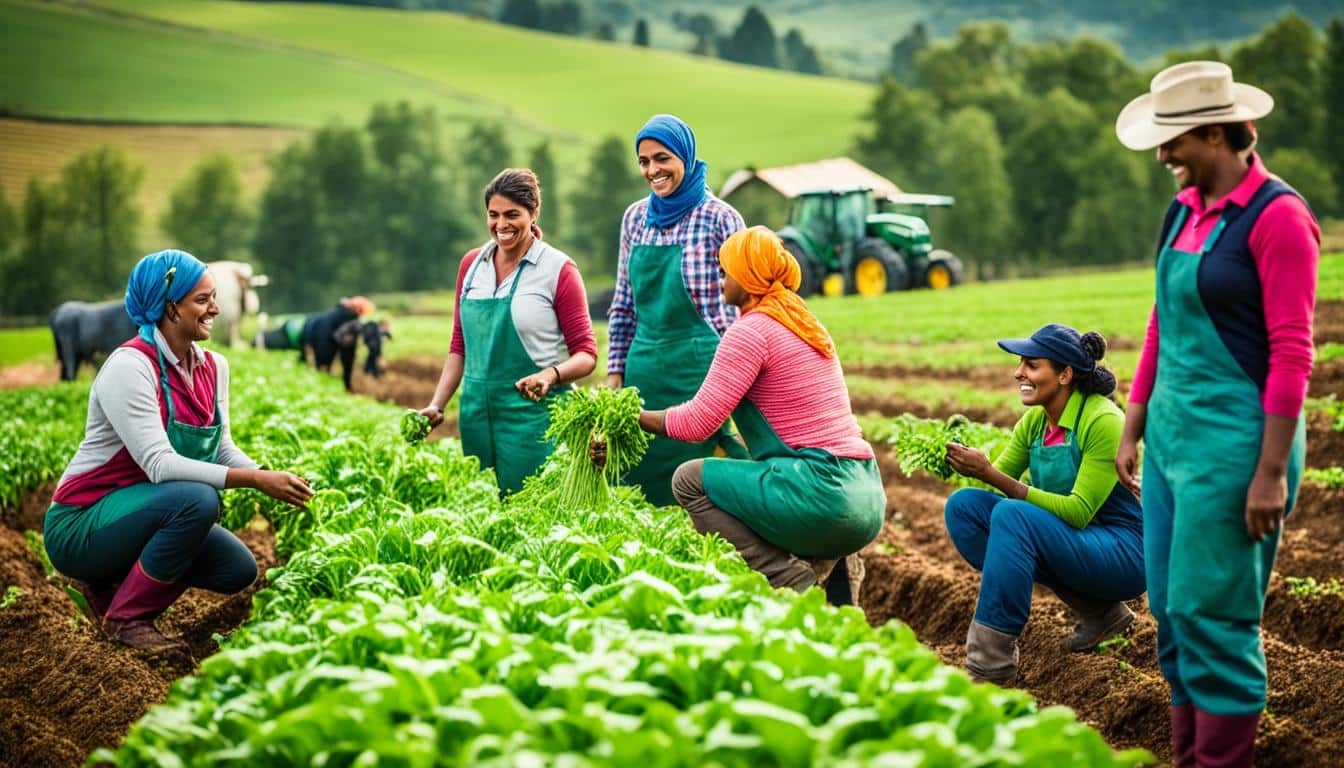
Did you know about 815 million people worldwide don’t have enough to eat? By 2050, we must make 50% more food to feed nine billion. We need to change how we farm to meet this huge demand. Gender equality in farming is a big part of the solution.
Many women work in agriculture in poor countries. They do a lot, from planting seeds to taking care of families. But, they don’t get the same support as men. They lack resources, tech, and money services. This makes them less productive. In some places, women do half the work but get 20-30% less food out of it.
Helping women farmers could do a lot for food and money. Programs that support women, like USAID’s Feed the Future, make a big difference. They help families eat better and earn more.
Making things fair for women in farming is a must. It’s not just about being right; it’s smart too. Giving women land, tools, and money helps everyone. It can cut hunger and grow the economy a lot.
In many developing countries, women make up 43% of agricultural workers. They do more than just farm. They take care of getting water and fuel, and look after the family. Still, they face challenges getting the land and funds they need to work.
Globally, women do a huge amount of the agricultural work. However, they have less of their own assets than men. This means less access to the things they need to farm, like seeds and money. Women in sub-Saharan Africa do nearly half the work but only have 15% of the land. This shows a big gap in ownership.
In Asia, women do 42% of the farming work but own just 11% of the land. These numbers call for changes. We need policies that give everyone fair chances when it comes to farming resources.
If we close this gap, agriculture could grow a lot. With better access to resources, women could produce 20-30% more. This could feed 150 million more people. It would be a huge step towards food security for all.
Also, focusing on gender equality could boost agricultural output by up to 4%. This would fight hunger and lift millions out of poverty. It would also help the economy grow, improving life for many.
Empowering women in agriculture could potentially feed an additional 150 million people globally.
We measure the progress of these efforts with the Women’s Empowerment in Agriculture Index. Programmes like the African Women in Agricultural Research and Development fellowship, backed by USAID, and projects promoting technology in Tanzania are examples. They show how focusing on women can bring real change.
| Region | % of Women in Agricultural Labour Force | % of Women Land Holders |
|---|---|---|
| Sub-Saharan Africa | 48.7% | 15% |
| Asia | 42% | 11% |
| Latin America | 20% | 18% |
| Middle East and North Africa | 40% | 5% |
To wrap up, fair farming policies and programmes not only help women. They also benefit the economy and society at large.
Women in farming face big hurdles that slow them down from being their most productive. They work hard, mostly at small farming. But, they often can’t get the same rights to land and materials as men.
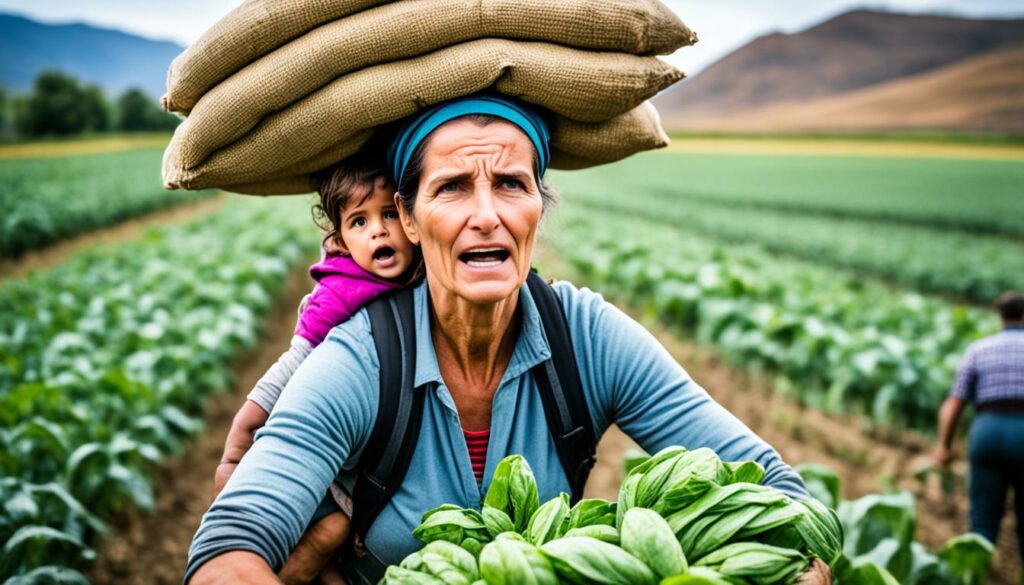
Getting land is a huge issue for women. In places like sub-Saharan Africa and Asia, women hold very little land. This problem makes it hard for them to use things like better seeds, fertilisers, and tools. So, they can’t grow as much food or be as important in farming.
Learning is also a problem. Many women in rural areas don’t know how to read and write. This stops them from learning the best ways to farm. They can’t use new methods that would help them grow more food. Solving this issue helps give women better chances to farm well and care for their families.
Money and loans are hard for women farmers to get. There are many reasons, like not having things to offer as a guarantee. Also, it costs too much to do the deals, and some cultures say women shouldn’t borrow money. Not having enough money means they can’t buy much-needed farming items or grow their farms. Helping women get loans and financial help is key to making farming fairer and helping them feed more people and grow their countries.
It’s key to boost women’s leadership in farming. Why? Because 43% of farm workers in developing places are women. Their role is huge. Give them more resources, and we could feed 150 million more people. This is a big step towards fairness in our world.
Looking at women who’ve led well helps others step up in farming. Take Jeet Kumari from Nepal. She showed amazing strength and new ideas. Her work made a big difference and made us see the power of women in farming.
Jeet Kumari stands out for promoting women in farming. She mixes old and new ways to farm better and careful of the earth. Her work inspires not just around her, but far. More women lead with her help, showing how powerful support for women is.
There are many efforts to help women lead in farming. The African Women in Agricultural Research and Development scheme is one. It boosts African women’s science and leadership skills. There’s also a programme that ensures advice given is friendly to all and helps people eat better. Both do a lot for women in farming.
The U.S. Department of Agriculture’s mentoring network is a great resource, too. It offers a newsletter with stories of women in farming. There’s also news and conferences info. It connects women so they can learn from each other. The USDA also hosts calls where successful women talk about their work.
USAID made a special index to see how well women are doing in farming. They’ve checked 13 countries to get started. This index helps plan and make programmes to support women. It aims to make farming fairer and more productive.
| Program | Focus | Impact |
|---|---|---|
| African Women in Agricultural Research and Development | Research and Leadership Skills | Strengthens women’s roles in agricultural science |
| Integrating Gender and Nutrition within Agriculture Extension Services | Gender-sensitive and Nutrition-enhancing Services | Promotes inclusive and effective advisory services |
| USDA Women in Agriculture Mentoring Network | Mentorship and Networking | Encourages female leadership and shared experiences |
These schemes are vital. They clear the way and provide what’s needed. Then, more women can lead in farming. This leads to better farming and more food for everyone, making our world a better place.
It’s crucial to have inclusive agricultural policies to close gender gaps. Less than 15% of landholders worldwide are women. We need initiatives that promote equality and empower women in farming. Government programmes that focus on this are very important.
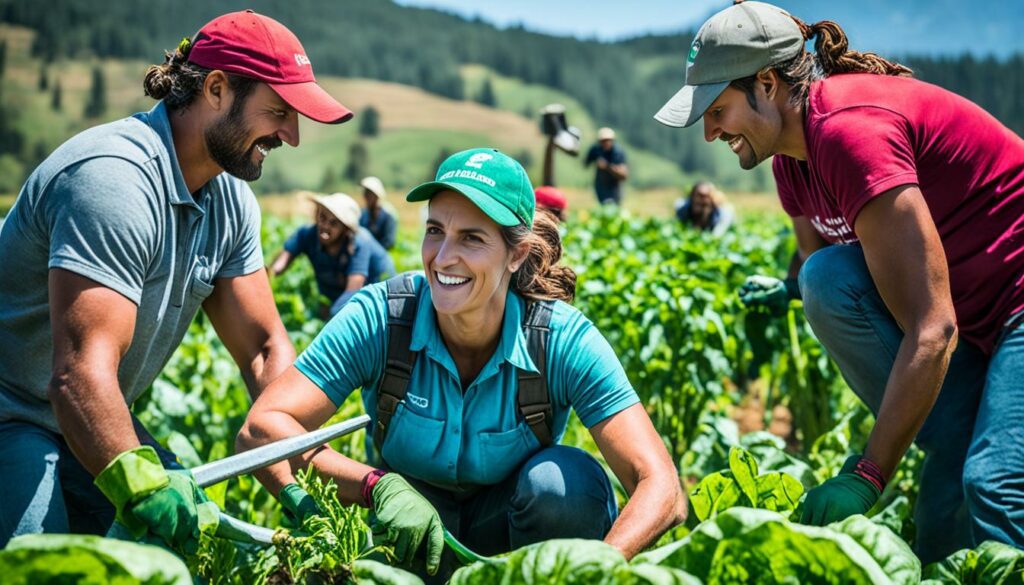
Government programmes are key in achieving gender equality in farming. For example, a partnership in 2018 between the Ethiopian Institute of Agricultural Research and the African Women in Agricultural Research and Development (AWARD). It launched the EIAR Institutional Fellowship. This matched young female researchers with experienced mentors. It aimed to bridge the education and training gap for women.
The GRASP Fellowship, funded by USAID, focuses on developing African women policy professionals. The goal is to have them advocate for and lead gender-friendly farm policy changes.
For lasting change, policies must address gender gaps directly. Recommendations include making it easy for women to own land and access financial services. Also, training programmes should be designed with gender in mind. This helps women be more productive and influential in farming.
The table below shows some important initiatives and what they focus on:
| Initiative | Focus Area | Impact |
|---|---|---|
| EIAR Institutional Fellowship | Education and Mentorship | Enhanced training and mentorship opportunities for young female researchers. |
| GRASP Fellowship | Policy Advocacy | Development of female policy professionals to lead gender-responsive changes. |
| USAID Feed the Future | Land Ownership | Strengthened women’s land tenure and financial service access. |
By implementing these policy suggestions, we can create a more fair and strong farming sector. With ongoing effort and smart policy changes, we can get closer to gender equality in agriculture.
Dealing with gender imbalances in farming is key. We need well-designed, gender-focused projects in agriculture. These projects help bring gender equality to farming. By considering women in all farming projects, we help them do as well as men.
Focused programs train women farmers. They aim to meet their particular needs. Through efforts like the Integrating Gender and Nutrition within Agriculture Extension Services, women gain skills to succeed in farming. This leads to better output and work efficiency.
The Organisation for Economic Co-operation and Development taking place in 2018–19 told that over 50% of training programmes included gender goals. Sadly, only 2.4% of the money was used towards this. It shows that we need to invest more in training that’s focused on gender.
It’s crucial for women to have access to up-to-date farming tech. Around the world, less than 15% of farm owners are women. This gender gap is also seen in the access to farming technology. Initiatives like Community-centred Technology Design teach women how to use new tech in farming.
They provide women with hands-on, tech-based solutions for farming. These tools help them farm sustainably. The UN Food and Agriculture Organization warns about large digital gaps between men and women. Therefore, focused programmes are needed to close this gap.
| Statistics | Details |
|---|---|
| Climate Policy Initiative 2019-20 | Only 11% (US$5 billion out of $46 billion) of climate funding was gender-tagged. |
| OECD 2018-19 | Over half of adaptation programming integrated gender equality objectives. |
| OECD 2018-19 | Only 2.4% of funding had gender equality as a principal objective. |
| FAO Data | Significant gender disparities in mobile and digital access persist. |
These gaps can be filled by setting clear gender goals and integrating them in every step of projects. This turns the talk of gender fairness in farming into real, funded actions.
For centuries, women have been the heart of farm work in the US and around the world. Yet, their hard work often goes unnoticed. This has led to the need for special programmes to help empower them. Groups like the USDA Women in Agriculture Mentoring Network are working to support and empower these women.
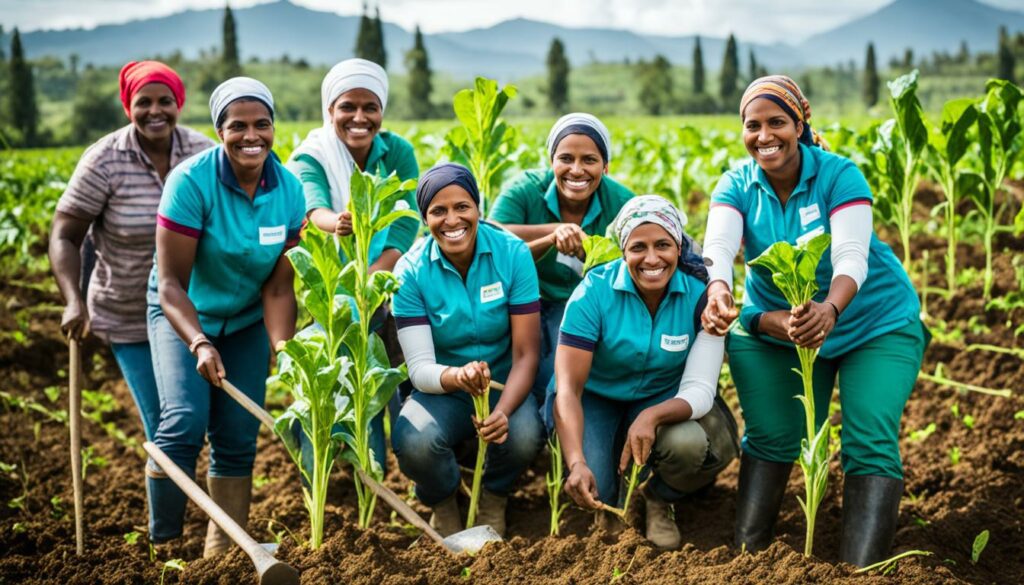
When we look at success stories, we see how important it is to provide education and resources to women farmers. In some places, women are almost half of those working in farming. Helping them produce as much as men could lower world hunger by 17 percent.
NGOs and global groups are vital for supporting women in farming. The USDA Mentoring Network organises calls with key people. They share knowledge on creating a better and more equal farming sector. Tools like the Women in Ag Roundtable Toolkit are used to organise events. These events can be small or large and help overcome challenges like little land access and fewer resources.
| Region | Percentage of Women in Agriculture | Challenges | Support Initiatives |
|---|---|---|---|
| South Asia | Over 67% | Limited access to land, loans, machinery | Mentorship programs, educational initiatives |
| Eastern Africa | Over 50% | Resource allocation, financial barriers | Networking support, capacity building |
Thanks to the work of NGOs and global partnerships, we are making a difference. We are securing the future for women farmers, increasing their output. Ultimately, we are helping to fight poverty and hunger.
Getting equal rights to land is key for gender equality in farming. Women make up a big part of the farm work but often find it hard to own land. In only 37 out of 161 countries, men and women have the same rights to land. This gap stops women from fully taking part in and getting benefits from farming.
Many laws and traditions push women away from owning land. These include laws and customs that favour men over women. Things like getting titles for land can be hard for women in rural areas. They might not have the same resources or help, making it tougher for them.
Efforts to give women more land rights are vital for farm gender balance. Organisations, like the African Women in Agricultural Research and Development (AWARD), are making a difference. They help women learn about owning land and push to remove blocks that stop women from farming fairly.
The 2030 Agenda is big on getting land rights for rural women, with new goals just for this. It says more must be done to help these women. By getting behind these efforts, we can help make farming fairer for women and boost food production and safety for everyone.
For more detailed info and stats on equal land rights, check out the UN’s press release on equal land rights.
| Country | Equal Land Ownership Rights |
|---|---|
| Kenya | No |
| Australia | Yes |
| India | Partial |
| Germany | Yes |
Female agricultural cooperatives shine as a beacon for women in farming, moving gender equality in the field forward. They help with community growth, better harvests, and food safety. With more than half of the people in Sub-Saharan Africa earning their living from farming, these efforts are vital for the area’s economy and social dynamics.
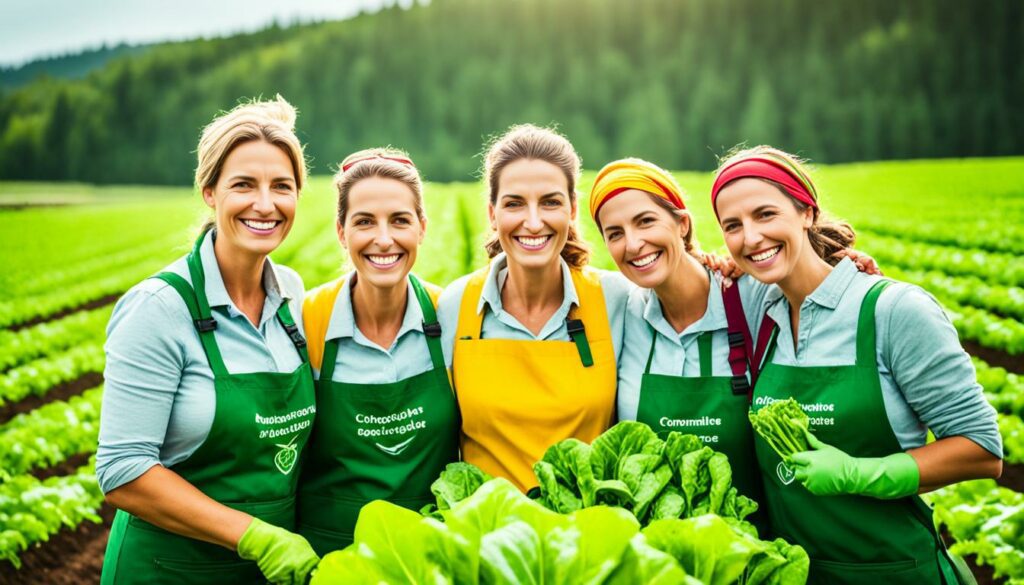
By coming together in female agricultural cooperatives, women share their resources and knowledge. This approach is key since cereal harvests in Sub-Saharan Africa lag behind the world average, leading more people into poverty over the years. The cooperatives boost the work of women, who make up most of the farming workforce, raising productivity and smarter use of resources.
The Phata Sugar Cooperative in Malawi, for instance, has notably improved. It showcased significant income growth with up to 44% of its members being women in 2016. Not only did Phata 1’s small farmers see their income go up by $234 per farmer, but they also boosted their community through better farming and new infrastructure.
The success of female agricultural cooperatives can be seen in many places worldwide. The African Development Bank has played a major role by funding these co-ops, including a $1.4 million grant for those in Chad and investing $76 million in Mozambique’s irrigation. Such help addresses female farmers’ unique challenges and helps them overcome obstacles.
Now, let’s compare some investments and their impacts:
| Country | Investment | Impact |
|---|---|---|
| Chad | $1.4 million grant | Enhanced networking and agricultural aid |
| Mozambique | $76 million investment | Improved irrigation infrastructure |
| Ghana | $20 million loan | Poultry processing and feed mill establishment |
| Tanzania | $118 million loan | Development of rural roads |
In Uganda, the Gulu Agricultural Development Company (GADC) helps 60% female farmers, boosting their yearly earnings by $251. These gains underline the importance of female-led groups in improving women’s standing in agriculture and highlight the power of such initiatives in battling poverty and making communities more resilient.
Across the globe, organisations are realising how crucial women are in leading sustainable farming efforts. They are taking the lead, using eco-friendly farming methods. These methods help ensure there’s enough food and protect the environment too.
Women farmers use innovative methods that not just help their local areas, but also make sure these places stay healthy for the future. In Tanzania, home gardens, part of the USAID-Tanzania Agriculture Program, have really boosted what families eat. By blending old and new farming approaches, they are also keeping the variety of plant and animal life around. This way, they manage to keep the land productive and protect the environment.
This work is vital for letting countryside areas grow and helping people live better and healthier lives. At the same time, they are looking after the planet by taking care of the land they farm on.
Putting money into helping women farmers can do a lot of good. Women in Africa are almost half of the people working in farming there, but they don’t own as much land as men. If we help them farm in sustainable ways, we could get a lot more food. This would cut down on hunger and make the economy stronger.
Places like Ghana, Mali, and Malawi have shown that helping women farmers pays off big. For every dollar spent on programs for sustainable farming, $31 come back. Plus, farming this way is a big help in fighting climate change. It cuts down on the harmful gases that come from traditional farming methods.
| Country | Investment in Agriculture Programs | Return on Investment |
|---|---|---|
| Ghana | $1 | $31 |
| Mali | $1 | $31 |
| Malawi | $1 | $31 |
Helping women use sustainable farming practices makes a big difference. It’s not just good for their families and local areas. It also helps the economy stand strong. Studies show, if we close the gap between men and women in farming, we could feed 150 million more people.
It’s crucial to boost female leadership in farming for both gender equality and improved farming. For centuries, women worldwide have been key in farming. Yet, they often can’t reach top roles.
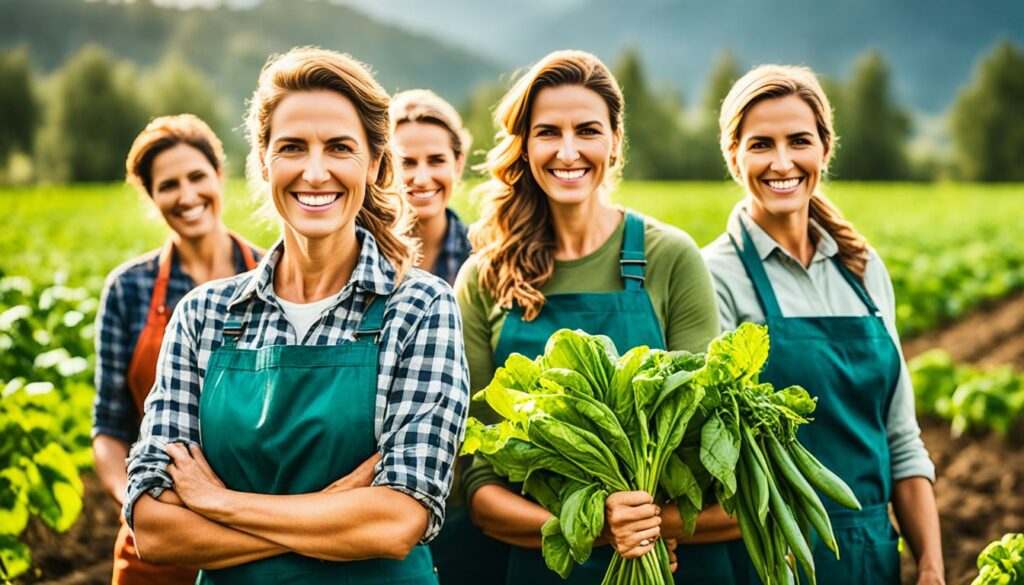
Training women is key in boosting their leadership. Programmes like Feed the Future and fellowships help them gain vital skills. For instance, the USDA network supports women with calls and news about successful women.
Overcoming hurdles to female leadership matters just as much. This means challenging old traditions, providing mentors, and ensuring women are part of important committees. These efforts, along with webinars and events, boost women’s involvement and show their achievements.
| Initiative | Impact |
|---|---|
| Feed the Future Program | Equips women with leadership skills |
| USDA Women in Agriculture Mentoring Network | Promotes women’s roles and leadership |
| Webinars and Local Events | Increases female participation and leadership |
| Awards for Female Innovators | Recognises and honours women’s contributions |
Focusing on female leadership and supporting women farmers can make farming more welcoming and successful. Key actions include training, breaking down biases, and giving credit for women’s work.
Gender equality in agriculture helps solve big issues like hunger and poverty. Despite doing a lot of the work, women often don’t own assets or get proper training. This holds back their work and hurts the world’s food supply.
Gender equality can directly fight hunger. Closing the gender gap could boost yields on women’s farms by 20-30%. This would ramp up agricultural output by 4% in poorer countries. It might cut global hunger by 17%, feeding 150 million more people.
Women are central in farming, yet they can fall behind men. They need better access to resources to catch up.
Initiatives like the Women’s Empowerment in Agriculture Index (WEAI) from USAID monitor women’s progress in farming. They check things like if women get to make decisions and have the resources they need.
Efforts like community-based tech training help women boost their farms. They focus on gender and nutrition, making farming more productive and tackling food security.
Pushing for gender fairness in agriculture has big benefits. It fights hunger, helps the economy grow, and makes our food systems stronger. When women thrive in farming, everyone enjoys better food and more economic chances.
Bringing gender equality to agriculture needs a thorough approach. This should break down the big barriers and allow fair use of resources and chances. By focusing on strategic actions and constant checks, we set the scene for farming that meets the needs of everyone. This is key for farming that lasts and benefits all.
The drive for equal rights in farming must first give women more access to land and money. With women making up 37% of farm workers, many get blocked by not being able to use land or get needed items like tools or seeds. It’s vital to change this with strong policies and support.
Every agriculture plan should deeply think about gender issues right from the start. The FAO, for instance, makes sure to think about equality in all their projects. They aim for fair chances for everyone.
Sharing knowledge and the latest farm tech with women is also key. Special programmes, such as the one focused on gender in agriculture and nutrition, help women get the skills and tech they need. This way, they can farm better and in ways that protect the environment.
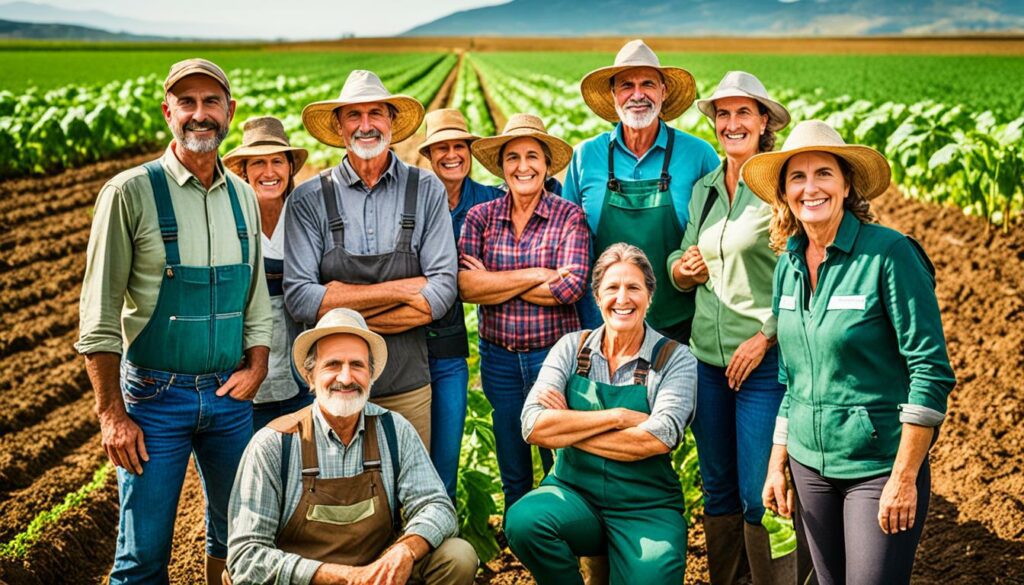
Checking on how well gender issues are handled in farming is crucial. Even though many climate projects don’t look enough at gender, tools like the Women’s Empowerment in Agriculture Index help us see how well we’re doing.
Making sure money and efforts are going where they should is also hard. Very little climate money is clearly marked for helping women. Keeping a close eye and spending well on gender fairness are needed to move forward.
Lastly, it’s vital to stick to high standards and solid plans for gender fairness. This means making sure our actions match what we say we’ll do and that we keep enough money for gender rights. This keeps us moving steadily towards a more equal farming world.
In the push for global food security, making sure women are equal in farming is key. Women are 43% of the farm workers in poorer countries. They are essential but face limits in resources. But if they had the same resources as men, they could grow more food. This could feed 150 million more people and help farming in a better way.
Programmes like those run by USAID and the Women’s Empowerment in Agriculture Index (WEAI) are important. They offer chances for women to learn and provide farming advice that fits women’s needs. These efforts break down obstacles faced by women now and set the stage for a better future. Helping women in farming is important for increasing food. This is critical as the world tries to feed nine billion by 2050.
Empowering women in farming leads to bigger changes. Despite doing a lot of farm work, women have less farm land and money than men. By closing these gaps, we can fight hunger, help the economy, and protect the environment. Gender-friendly farm projects and giving more female leaders in farming can make the future fairer and richer. Pushing for equal chances in farming is practical and smart for a world that’s sustainable and well-fed.
Boosting gender equality in farming is vital. It helps improve food security and the economy. Plus, it’s good for our planet. Women are key in farming. By empowering them, we can up productivity and yields.
Closing this gap could boost crop output by 4% in poorer places. If women had equal resources like men, their harvests might rise by 20-30%. This could help feed 150 million more people. It would also cut down on hunger and poverty.
Women in farming deal with not having full access to land and resources. They often get less education than men. Plus, they find it hard to get loans and other financial help. These challenges lower their output and widen the gender gap in farming.
To boost women’s role, we need to offer them training and tools. Programmes that support them, like the African Women in Agricultural Research and Development, are working. They aim to up women’s leadership in farming science and communities.
Government actions are key in making farming equal for everyone. Programmes such as USAID’s Feed the Future work on empowering women. They focus on policies that help women own land and get better financial services.
These programmes are tailored to fix gender gaps. They offer training and help build women’s skills. They also make sure women can use modern farming tools. This helps them farm more efficiently.
Cooperatives led by women, like Jeet Kumari’s in Nepal, have made great strides. They help push for gender equality and community growth. These groups connect women, offer farming aid, and focus on sustainable methods. They’re a big help in making sure there’s enough food.
Letting women have the same right to land is crucial. Many face barriers, both legally and culturally. Helping women own land removes these challenges. It lets them boost agricultural output more effectively.
Women often use earth-friendly farming, like home gardens, to better what they eat. They combine the old ways of farming with new ones to protect plant and animal life. These ways tackle both hunger and climate change.
Getting more women to lead in farming is key for progress and fairness. Efforts that teach and guide women give them the needed know-how. This breaks down walls and sparks new ideas.
Bringing equality to farming can cut world hunger by 17%. Projects such as the Women’s Empowerment in Agriculture Index make a change. They work on including women and measuring results. This leads to better nutrition, growth, and strong food systems around the globe.
To reach equality, we should give women better access to things like land. We need to fight for their rights and put efforts into teaching and tech for them. Keeping track with tools like the WEAI will keep us focused on making lasting changes.